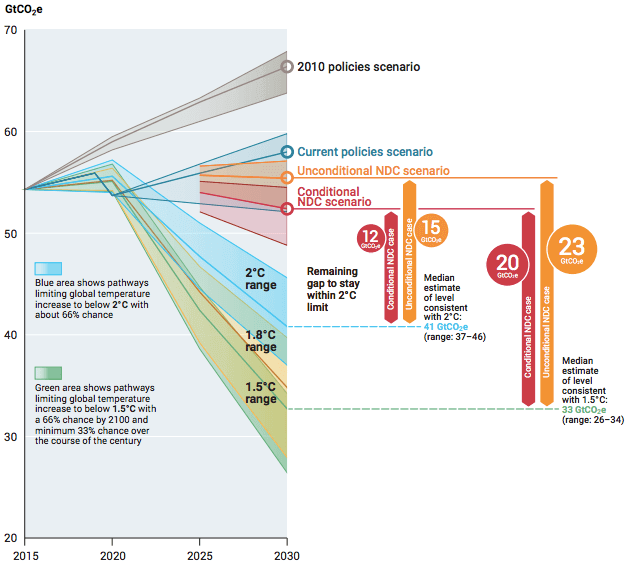Closing the Emissions Gap
The acceptable emissions in 2030 for a 1.5°C world are 33 GtCO₂e globally. However, according to the latest research, current climate pledges and commitments are not enough to meet this goal. With our current targets, we are expected to emit 53-56 GtCO₂e in 2030, resulting in an emissions gap of 20–23 GtCO₂e respectively for conditional and unconditional nationally determined contribution (NDC).
In order to avoid dangerous climate change, global emissions must become net negative after 2050. This means that more carbon needs to be trapped or removed from the atmosphere than is released. While this may sound daunting, the Paris Agreement has already driven significant climate action. According to estimates, actions taken since 2015 have potentially reduced the 2030 warming by only 0.5°C.
The transition to renewable energy has been a major contributor to this progress. However, it is crucial that we close the remaining emissions gap to meet the 1.5°C goal and avoid dangerous climate change. The United Nations Environment Programme (UNEP) estimates that an annual reduction rate of 7.6% will be necessary to meet this goal.
Current policies put our planet on a pathway towards average temperatures of 1.2-1.3°C higher than the "Net Zero target" projections (with a 90% chance). This highlights the need for more ambitious and urgent action to close the emissions gap and meet the 1.5°C goal of the Paris Agreement. The choices we make now will have a significant impact on the future of our planet and all its inhabitants.
To achieve the necessary emissions reductions, it will be important to adopt a holistic approach that addresses all sectors of the economy. This includes the energy, transportation, agriculture, and industrial sectors. Additionally, implementing carbon pricing mechanisms, such as a carbon tax or cap-and-trade system, can help to incentivize the transition to low-carbon technologies and practices.
Finally, it is essential to engage all levels of society in the transition to a low-carbon future. This includes individuals, businesses, and governments. By working together and taking bold action, we can close the emissions gap and create a more sustainable and prosperous future for all.
References:
United Nations Environment Programme (UNEP). (2022). Emissions Gap Report 2022. Nairobi, Kenya: UNEP. https://www.unenvironment.org/resources/emissions-gap-report-2022
Intergovernmental Panel on Climate Change (IPCC). (2018). Global warming of 1.5°C. Geneva, Switzerland: IPCC. https://www.ipcc.ch/sr15/
International Energy Agency (IEA). (2021). Energy and climate change. https://www.iea.org/topics/energy-and-climate-change
World Bank. (2020). Carbon pricing. https://www.worldbank.org/en/topic/climatefinance/brief/carbon-pricing

